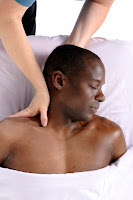There are many types of bodywork available to use in care for oneself. One such type is massage therapy and within that umbrella, there are countless modalities being utilized. I practice the following forms of massage therapy and generally tend to integrate them into a symphony of hands-on work for my clients: Swedish, Deep Tissue, Neuromuscular, Sports, and CranioSacral Therapy.
SWEDISH MASSAGE: A form of massage therapy where the therapist employs long, rhythmic strokes to the client's muscle structure. The use of oil or lotion is important as it allows the therapist's hands to glide smoothly creating a rolling out of the muscle tissue. This fluid movement generally moves towards the heart and the pressure tends to be fairly light and relaxing. Most find this form of massage to be very stress-relieving and it is even common to fall asleep.
DEEP TISSUE MASSAGE: Massage using long, deep, and slow strokes intending to gain access to the deeper layers of muscle and connective tissue. The goal is to create change in chronically bound-up tissues and adheasions. Adheasions are bands of rigid tissue that can be quite painful as they can block circulation, create limited movement, and inflammation. The use of lotion or oil is very minimal if at all. This allows the therapist to gain the depth of pressure needed to create positive change. Though at points there can be discomfort due to the pressure used, it should not be painful enough to create bruising or extreme tenderness post-massage.
NEUROMUSCULAR MASSAGE: This approach is quite similar to Deep Tissue in that it addresses both muscle and the connective tissues that encase these muscles. The strokes are not generally as long nor are they as slow; however, the use of lotion or oil is still very limited if at all. The angle of the practitioner's hands changes too in order to work on more specific points in the tissues called trigger points. This can be uncomfortable for the client at points; however, the end result is better movement in the tissues and better blood flow. In many cases the breaking up of scar tissue can even be achieved.
SPORTS MASSAGE: This form of massage is typically focused on a specific part of the body rather than the full body. It is used to enhance athletic performance, improve recovery, but is not only meant for professional athletes. Many therapist will blend stretching and manual muscle manipulation to achieve the goal of optimal performance. The pace of this work is faster than most massage therapies and goals are often reached much quicker and on the spot.
CRANIOSACRAL THERAPY: Very subtle pressure is utilized to create changes in the central nervous system (CNS). This is done by using pressure of no more than a nickel to convince the structure of the body to move into a place of balance. Once the structure is properly aligned, the cerebral spinal fluid is allowed to flow more naturally through the CNS. The work is typically done with the client clothed and there is no need for oil or lotion. While receiving this work it is very common to fall into a dream-like state or even fall completely asleep on the massage table.
This is by no means a complete list of therapeutic massage modalities - in fact, it is far from it! My goal to give a brief overview of the therapies I am currently trained to provide so that my clients can know more about what they are receiving. In future blog posts, I will go into greater depth on the above to provide further education on my passion.




No comments:
Post a Comment